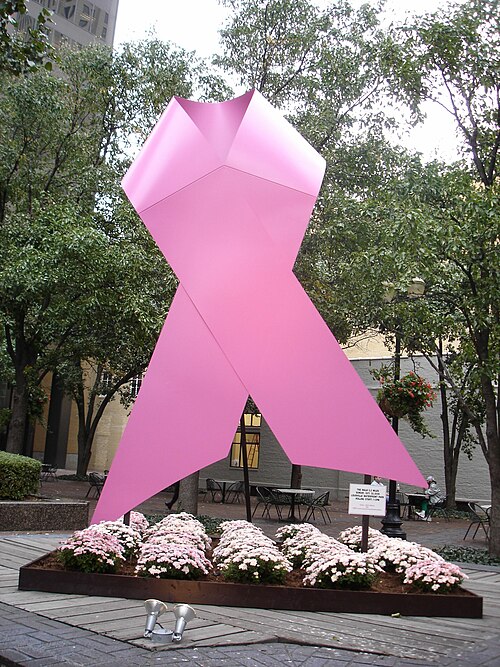The Woman in Pink
Traditionally pink has been the go-to color for girls, Barbie’s preferred hue, and a mention in a Molly Ringwald film. In the last decade of the 20th century, pink became a ubiquitous shade, evocative of an equal opportunity slayer.
The genesis of an icon began with the 1972 Tony Orlando song. A man wrote his wife if she wanted him back, she was to “tie a yellow ribbon tied around the ole oak tree” of their home. When he approached, he did not see one - he saw one hundred. Seven years later, in a nod to the hit single, Penny Laingen fastened her own around the tree in her yard, in prayer husband Bruce, an Iranian hostage, would be released. In the 1980s it became a sign of solidarity for the soldiers fighting in the Gulf War. AIDS activists wanted something for the boys dying back home and changed its color to red. The ribbon was destined to undergo another metamorphosis. 
Evelyn, the woman who would mix pink alongside October’s autumnal colors, was born in 1936 in Vienna, the only child of Ernest and Mimi Hausner. Her father lived in Poland and Berlin and settled in Austria with his wife, daughter of a Viennese lumber merchant. Ernest owned a profitable lingerie shop; post Anschluss, as a Jewish-owned business, it carried an expiration date. After Kristallnacht, a Nazi officer announced a partnership in the lingerie shop. Understanding the ramification, the Hausners fled to the border, trading family silver for exit visas. They first went to Belgium, then to England. To their horror, Britain did not prove to be a sanctuary. At the outbreak of war, its government, fearing German spies, arrested Mimi and interred her in the Isle of Man. Evelyn later recalled how the separation from her mother-and the Blitz- proved traumatic. Her husband was able to secure Mimi’s release, and the Hausners sailed to New York. Mimi woke Evelyn to show her the Statue of Liberty who promised the American Dream. In the competitive immigrant community, Ernest worked as a diamond cutter for several years until he established Lamay, a dress shop in Manhattan and eventually expanded the business to include five more stores.
Evelyn enrolled at Hunter College, working between semesters at a Barnes & Noble. At age 18, on a blind date, she met Leonard, a naval officer, elder son of Estèe Lauder. She agreed to a second date, although she set her heart on snagging a lawyer. Estèe, who liked the girl, a younger version of herself, asked Evelyn to be the hostess for her son’s birthday party. “So I stayed,” Evelyn recalled. “What could I do? She was like a steamroller.” The romance almost ended before it began, and she recalled, “My father loved him, and I was at the stage where anything my father approved of, I didn’t-so that killed it for a while.” In hindsight her father did know best, and Evelyn and Leonard married four years later with a reception at the Plaza Hotel. On her wedding-day, Estèe told her daughter-in-law, “Now that you are going to be Mrs. Lauder, you can’t go in the street without wearing your make-up.” Evelyn quit her job as a Harlem public school teacher and joined her husband in the fledging cosmetics company, launched by his mother in 1946. In the early days of her marriage, she would return to their apartment to find Estèe had rearranged all the furniture. Evelyn recalled that Estée, “would put the furniture one way. When she left, I moved it right back. Then she’d come a couple of days later and move it her way again. I’d move it right back. Finally, she walked in one day and said, ‘I guess I ought to leave it alone.’ I just replied, ‘It might be nice.’” It was furniture as power play. Despite her dynamo mother-in-law as boss, Evelyn held her own. She explained, “I was very strong. Having had a childhood like the one I had, I was much more tough than a lot of people. I was one of the few people who spoke my mind to Estèe.”
At this juncture there were only six Lauder products: a red lipstick, creams, lotions, and Youth Dew fragrance in a bath oil with sales under $1 million. These were the days when Evelyn answered the phone in different voices to convince callers the company was far larger than its reality. While Estèe was the namesake and head honcho, it was Evelyn who helped transform the eponymous cosmetics company into an international empire and made her its Crown Princess. She partially accomplished this feat by coming up with classics such as cheek color in the form of colored pressed powder and lip gloss in a lipstick tube rather than a pot. As the firm continued to rise, it acquired satellites such as Clinique-so named by Evelyn-, Origins, Prescriptive, and Aramis. Success arrived when the company sold directly to beauty salons and department stores.
Through the Lauders’ acumen, the family-owned company became a two-billion-dollar enterprise and the once penniless refugee was among the Fortune 400; Evelyn became a socialite around whom Manhattan society orbited. In 2008 she merited inclusion on Vanity Fair’s International Best Dressed List. However, under the understated designer clothes was a will of steel. The secret to her svelte figure lies in her quotation, “Whenever a waiter asks me if I’d like dessert, I tell him, ‘I can’t. I’m suffering from a condition called Fatonmythighs.’ If you say it fast it sounds downright medical.” Her penthouse on Fifth Avenue held a significant collection of modern art including works of Picasso. Despite her high profile in society, Evelyn was extremely private and shared only the most cursory details regarding sons, William and Gary. She shunned public intrusion on the couple’s homes in Manhattan, Aspen, and a rustic retreat in upstate New York. In the latter Evelyn - an accomplished cook - prepared German food for family and friends.
Even the most charmed existence was no armor against the slings and arrows of the breast cancer with which she was diagnosed in 1989. With her characteristic grit, Evelyn determined she would spend her days living with - rather than dying from - the disease. Through it she also found her life’s great crusade: a warrior against the scourge ravaging her body. She raised a good part of the $13.6 million for the construction of the Evelyn H. Lauder Breast Center at the Memorial Sloan-Kettering Center that opened in October, 1999. In addition, she arranged for another $5 million for an endowment for its clinical research branch. That might have been fait accompli for most. It was just the end of Phase 1 for Mrs. Lauder. Two years later she set up the Breast Cancer Research Foundation that generates funds for eight medical institutions around the country. Leonard, the company’s chief executive, underwrote the cost of registering the foundation in every state. To date it has generated upwards of $350 million. Although a tireless campaigner, she was always reluctant to discuss her own condition. “My situation doesn’t really matter,” she told a reporter in 1995 in a voice that brooked no further probing. “The fact that I’m an activist is what’s important.”
Rival make-up mogul Charles Revson claimed, “In the factory we make cosmetics. In the store we sell hope.” And hope was what Evelyn did her best to bequeath to fellow victims of cancer. In her long career as an executive, she worked with many shades and hues, but pink was the color that changed her life. In partnership with Alexandra Penney, then editor-in-chief at Self magazine, Ms. Lauder created the pink ribbon campaign aimed at breast cancer awareness. It began with Evelyn and Leonard financing millions of pink bows handed out to women at Estèe Lauder department store make-up counters along with self-examination cards. This giveaway grew into fund-raising projects that led to Congress designating October as Breast Cancer Awareness Month. Evelyn said of the icon she launched, “There had been no publicity about breast cancer, but a confluence of events-the pink ribbon, the color, the press, partnering with Elizabeth Hurley, having Estèe Lauder as an advertiser in magazines and persuading so many of my friends who are health and beauty editors to do stories about breast health-got people talking.” A flight attendant noticed the pink ribbon on Lauder’s lapel and mentioned she knew what it represented. Lauder remarked, “From there, it became ubiquitous.” Unsurprisingly, a new shade of lipstick, Pink Ribbon, debuted and generated $120,000 in its first year.
Mrs. Lauder earned a Guinness World Record by starting a tradition whereby historic landmarks are illuminated in pink lights during the month of October to focus attention on the killer. Each year prominent sites around the world participate - including Niagara Falls, The Tower of London, and The Leaning Tower of Pisa. For her indefatigable efforts, she received the Carnegie Medal of Philanthropy. Evelyn’s relentless energy was only slowed in 2007 when she developed the ovarian cancer that led to her death in 2011. Fifteen hundred people attended her funeral, and the Empire State Building was bathed in pink to mark her passing.
In 2006 Ronald purchased Gustav Klimt’s portrait of Adele Bloch-Bauer for $135 million. No doubt its subject - a Jewish, Viennese woman - holds a personal connection. The masterpiece had long been engaged in a legal tug-of-war between Adele’s niece and an Austrian museum. It is the crown jewel of Ronald’s Manhattan art gallery. As priceless as the painting of the Woman in Gold, dearer still is the memory of his sister-in-law--the woman of pink.
(Chapter from Women Who Launch: Women Who Shattered Glass Ceilings)


